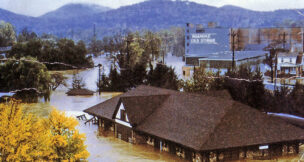Weathering a crisis
Coal ash spill overshadowed major changes in city’s River District
Weathering a crisis
Coal ash spill overshadowed major changes in city’s River District
A mishap last winter resulted in coal ash spilling into the Dan River at a time when Danville is making the river a focus of its downtown redevelopment initiative.
Six months later, the widely publicized spill appears to have no effect on the city’s water supply, but Danville officials still are assessing whether the event has done any damage to its image.
On Feb. 2, a pipe broke under the primary coal ash basin at Duke Energy’s shuttered Dan River Station plant in Eden, N.C, spewing into the river up to 39,000 tons of coal ash — the waste left when coal is burned — along with up to 27,000 gallons of contaminated water. The ash flowed downstream 20 miles toward Danville, its first stop along its route to Kerr Lake, a drinking water supply for numerous Virginia and North Carolina communities.
Coal ash contains toxic chemicals and heavy metals, including arsenic, lead, selenium and mercury.
Danville held its breath — its drinking water supply is drawn from the Dan River — but the city’s water treatment plant was able to filter out toxic chemicals to levels acceptable under federal guidelines, even as the normally muddy-brown river turned a silvery gray.
Overseen by the U.S. Environmental Protection Agency, efforts to track the coal ash began with constant water quality tests being taken by various agencies and private environmental groups. Duke Energy used a vacuum dredge to clean up a large deposit at the spill site and located two other substantial deposits, one in Danville and one just downstream of Eden.
A vacuum dredge was set up at the Danville site in April, and work at the Eden site began in June, according to a report Davis Montgomery, Duke Energy’s district manager, gave to Danville City Council in June.
City officials are cautiously optimistic. With the drinking water continuing to be safe and no large “fish kills” found, had the fast-moving river managed to dissipate the coal ash to a far less dangerous level than immediately feared? That’s an answer that could take decades to know for certain. In mid-July, the EPA said the river’s water quality had returned to normal, and Duke Energy announced that it had completed its cleanup along the river.
Danville City Council members and the city manager expressed fears of the impact the spill could have on the city’s economic development efforts. The city is in the midst of a major downtown renovation, with the area rebranded as the River District to take advantage of its view of the Dan River.
Traffic has been rerouted to allow the construction of a large plaza at the main downtown intersection, complete with a large landmark fountain, overlooking the river. The city’s Riverwalk Trail is being expanded.
Marketing efforts to attract new businesses tout the river’s scenic beauty.
“I don’t want to minimize what happened,” City Manager Joe King says. “But having learned a little about the TVA coal ash spill [a massive 2008 spill at the Tennessee Valley Authority Kingston Fossil Plant in Tennessee], once any deposits are removed from the river, there should be no lasting effects.”
While he has not been asked directly about the coal ash spill by economic development prospects, rumors abound that competing jurisdictions have brought it up to prospects, he says.
“What has occurred is hard to put a value on,” King says. “There has been local, regional, national coverage [of the effects of] toxic coal ash when we were putting emphasis on the river and the River District.”
King says that while such coverage is harmful, it is not yet known what the impact will be.
New plaza, fountain
In the meantime, work continues downtown. A new YMCA building — the first building to be built facing the river in more than a century — is nearing completion. In addition, the downtown fire station headquarters will be moving from its cramped quarters on Bridge Street, where modern fire trucks barely fit through its more-than-125-year-old doors, to the almost-finished new fire/emergency services complex on Lynn Street. Both projects replace eyesores: the YMCA at the former Long Mill site, burned in 2008, and the fire department at an also-burned-out former lumber company site.
The new Main Street Plaza and its JTI Fountain — the entire $465,000 price tag was donated by JTI Leaf Services — was officially unveiled in April. The fountain’s seven jets and scuppers represent the seven blocks that make up the Tobacco Warehouse District.
As hoped, the fountain has been a draw for the River District. During prom season, long lines of formally dressed students from area high schools lined up to take photos there; lines also formed during graduation season. An area that once saw almost zero foot traffic now is rarely empty. Four free concerts are scheduled for Thursday nights through the summer, and a recent scavenger hunt, sponsored by the Downtown Danville Association, drew hundreds to the plaza to compete for a $500 cash prize by visiting stores and businesses up and down Main Street.
Main Street Plaza also leads to a new Riverwalk Trail trailhead, one designed to be handicapped-accessible. The final phase of the project, to be done this year, will add public restrooms for Riverwalk Trail users and Main Street Plaza visitors.
The plaza sits at the base of King Memorial Bridge, a main connector for getting traffic across the Dan River. It, too, faces some remodeling this year. Its three northbound lanes will be cut back to two, making way for a pedestrian/bicycle lane, connecting the Riverwalk Trail on the north and south sides of the river.
Four blocks of Main Street saw sidewalks widened and made more attractive with brick, pavers and cobbles; intersections were improved; benches were placed and trees planted over the past year, and another phase of the streetscape project will make similar improvements along Craghead Street this year.
Downtown proponent
One of the biggest proponents of the River District is Karl Stauber, president and CEO of the Danville Regional Foundation. Convinced that downtown Danville could be revived, he took Danville City Council and city department heads to Greenville, S.C., to show them how a former mill-dominated city could turn itself around.
“We wanted to help them see the possible — and they did see the possible,” Stauber says. “They came back seeing the River District as a great asset.”
Consolidating what used to be seen as separate areas — downtown and the Tobacco Warehouse District — into the River District was a key decision, Stauber says, making it a unified place and a source of energy for the region.
The foundation kick-started the development of the River District by giving the Industrial Development Authority $1.2 million to purchase and demolish a long-empty building on an important corner on Main Street — a structure Stauber calls “a symbol of failure.”
“That turned a liability into an asset,” Stauber says.
Buildings identified by planning experts as key to turning the River District around have all been redeveloped or are in the redevelopment process, Stauber notes.
“Three-and-a-half years ago, 400 people were living in the River District, according to the economic development department,” Stauber says. “Now, there are 2,200 people living in the River District … the city and the foundation have spent $25 million upgrading infrastructure and some buildings — the private sector has spent $80 million.”
Work on industrial sites
As Danville continues downtown development, it is also working on some new industrial sites. The first phase of development has begun at a 165-acre site on Gypsum Road, and the Industrial Development Authority has purchased the 82-acre former Dan River Inc. Schoolfield Mill site for development.
There also is a joint city and county effort to develop a 3,500-acre mega park site through the Danville-Pittsylvania Regional Industrial Facility Authority, the third industrial park on which the two localities have collaborated on to share costs and profits.
Outside of its RIFA projects, Pittsylvania County has no formal economic development plan in place. In March 2013, the board of supervisors narrowly voted to dissolve its economic development department. Since then, responsibility for economic development efforts have fallen on Greg Sides, the county’s assistant county administrator for planning and development.
That is a situation Jessie Barksdale, elected as the board chair in January, wants to change.
“Greg is doing a wonderful job, but he has a host of duties to do daily,” Barksdale says.
Danville’s new economic development director, Telly D. Tucker, began work on July 1. He had been assistant economic development director in James City County.
Tucker wants to continue the city’s current push to recruit more foreign investment — there are 10 foreign companies from nine counties currently doing business in the Danville area — while increasing attention to existing businesses.
“I’m impressed with some of the successes Danville has had with international recruitment,” Tucker says, adding that he agrees with the city’s recent decision to slow recruitment of start-ups and focus on larger, established, advanced manufacturing prospects.
Attention to existing companies is also crucial, Tucker says. “We need to get out in the community and see if there are opportunities to help them grow. If we take care of the existing companies, they become the cheerleaders for new ones, because new prospects often ask existing companies how the city responds to them.”
-














